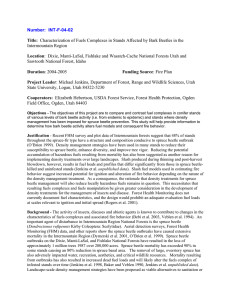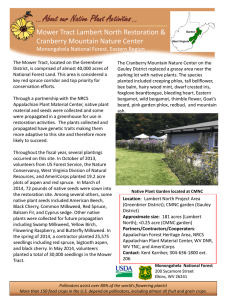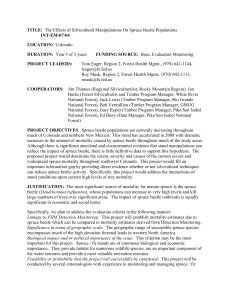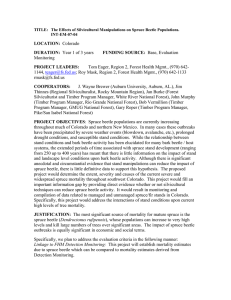INT-F-04-02
advertisement
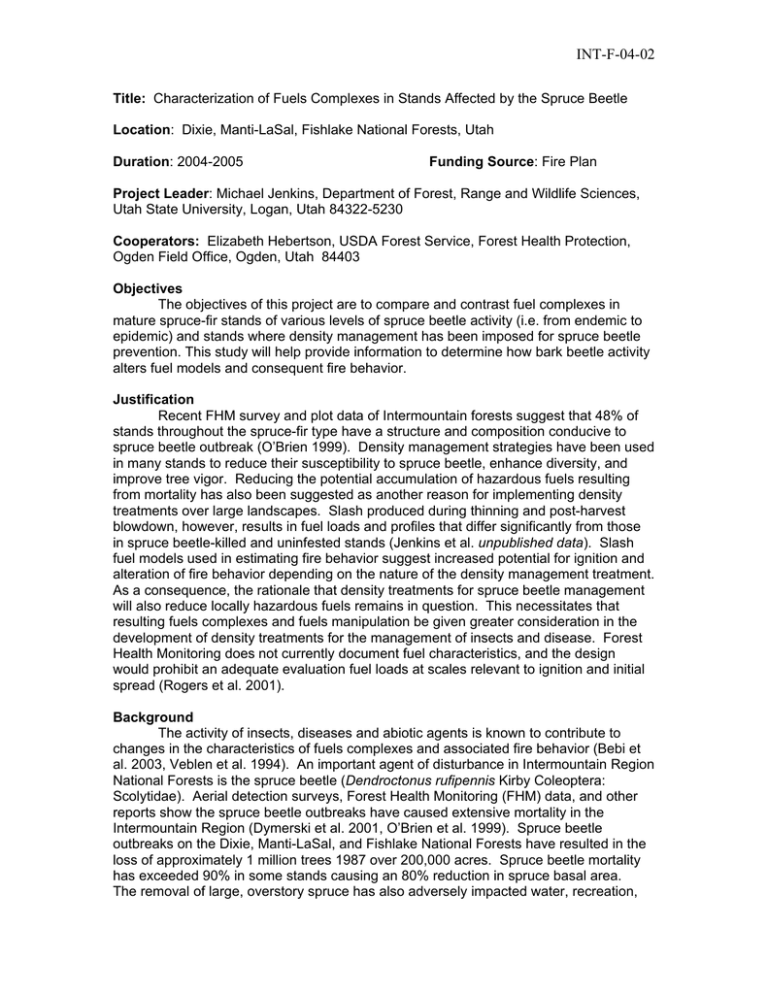
INT-F-04-02 Title: Characterization of Fuels Complexes in Stands Affected by the Spruce Beetle Location: Dixie, Manti-LaSal, Fishlake National Forests, Utah Duration: 2004-2005 Funding Source: Fire Plan Project Leader: Michael Jenkins, Department of Forest, Range and Wildlife Sciences, Utah State University, Logan, Utah 84322-5230 Cooperators: Elizabeth Hebertson, USDA Forest Service, Forest Health Protection, Ogden Field Office, Ogden, Utah 84403 Objectives The objectives of this project are to compare and contrast fuel complexes in mature spruce-fir stands of various levels of spruce beetle activity (i.e. from endemic to epidemic) and stands where density management has been imposed for spruce beetle prevention. This study will help provide information to determine how bark beetle activity alters fuel models and consequent fire behavior. Justification Recent FHM survey and plot data of Intermountain forests suggest that 48% of stands throughout the spruce-fir type have a structure and composition conducive to spruce beetle outbreak (O’Brien 1999). Density management strategies have been used in many stands to reduce their susceptibility to spruce beetle, enhance diversity, and improve tree vigor. Reducing the potential accumulation of hazardous fuels resulting from mortality has also been suggested as another reason for implementing density treatments over large landscapes. Slash produced during thinning and post-harvest blowdown, however, results in fuel loads and profiles that differ significantly from those in spruce beetle-killed and uninfested stands (Jenkins et al. unpublished data). Slash fuel models used in estimating fire behavior suggest increased potential for ignition and alteration of fire behavior depending on the nature of the density management treatment. As a consequence, the rationale that density treatments for spruce beetle management will also reduce locally hazardous fuels remains in question. This necessitates that resulting fuels complexes and fuels manipulation be given greater consideration in the development of density treatments for the management of insects and disease. Forest Health Monitoring does not currently document fuel characteristics, and the design would prohibit an adequate evaluation fuel loads at scales relevant to ignition and initial spread (Rogers et al. 2001). Background The activity of insects, diseases and abiotic agents is known to contribute to changes in the characteristics of fuels complexes and associated fire behavior (Bebi et al. 2003, Veblen et al. 1994). An important agent of disturbance in Intermountain Region National Forests is the spruce beetle (Dendroctonus rufipennis Kirby Coleoptera: Scolytidae). Aerial detection surveys, Forest Health Monitoring (FHM) data, and other reports show the spruce beetle outbreaks have caused extensive mortality in the Intermountain Region (Dymerski et al. 2001, O’Brien et al. 1999). Spruce beetle outbreaks on the Dixie, Manti-LaSal, and Fishlake National Forests have resulted in the loss of approximately 1 million trees 1987 over 200,000 acres. Spruce beetle mortality has exceeded 90% in some stands causing an 80% reduction in spruce basal area. The removal of large, overstory spruce has also adversely impacted water, recreation, 2 aesthetics, and critical wildlife resources. Mortality resulting from outbreaks has also resulted in increased dead fuel loads and will likely alter the fuels complex of infested stands over time (Jenkins et al. 1998, Baker and Veblen 1990, Jenkins et al. unpublished data). Landscape-scale density management strategies have been proposed as viable alternatives to sanitation or salvage for managing insect and disease outbreaks. The effect of outbreaks and various density treatments on fuels complexes, or fuels development, however, is not known. Materials and Methods Forest Health Monitoring and aerial detection survey data will be used to locate stands susceptible to spruce beetle outbreak, treated stands, and stands where spruce beetle populations have recently reached outbreak levels. Permanent plots will then be systematically established in these various stands. From each plot center, six 35’ Brown’s planar intersect transects for dead and down fuel measurements (Brown 1974). Fuels transects will be randomly established from the end of 100’ lines that radiate outward from plot center at 60° intervals. Metal stakes will permanently locate the beginning of each fuels transect for future measurements. Transects will also be photographed for documenting fuel arrangements and profiles. Additional transect information collected will include slope angle and aspect. Analysis of variance will be used to test mean differences of fuel loads in treated and untreated plots. Fuels inventory and appraisal will provide information needed for fuel model designation. Uninfested, coniferous timber stands generally fall into fire behavior fuel model 8. Bark beetle outbreaks typically convert these stands to fuel model 10 while thinning can create fuel conditions typical of slash fuel models 11 or 12. Under constant conditions of topography, wind and fuel moisture fire behavior will be predicted to vary widely within the different fuel model conditions present. Products: 1) guidelines for improved evaluation/assessment of fuels in bark beetle affected stands, 2) poster/presentation 3) peer-reviewed publication Schedule of Activities: 2004-plot establishment/data collection 2005- complete data collection, data analyses, completion of products Literature Cited: Baker, W.L., T.T. Veblen. Spruce beetle and fires in the nineteenth-century subalpine forests of western Colorado, USA. Arctic and Alpine Research, Occ. Paper. No. 23. Bebi, P., D. Kulakowski, T.T. Veblen. 2003. Interactions between fire and spruce beetles in a subalpine Rocky Mountain forest landscape. Ecology 84(2): 362-371 Dymerski A.D., J.A. Anhold, A.S. Munson. 2001. Spruce beetle (Dendroctonus rufipennis) outbreak in Engelmann spruce (Picea engelmannii) in central Utah, 19861998. Western North American Naturalist 61(1): 19-23 Jenkins, M.J., C.A. Dicus, E.G. Hebertson. 1998. Postfire succession and disturbance interactions on an Intermountain subalpine spruce-fir forest. In Teresa L. Pruden and Leonard A. Brennan (eds.). Fire in ecosystem management: shifting the paradigm from suppression to prescription. Tall Timbers Fire Ecology Conference Proceedings, No. 20. Tall Timbers Research Station, Tallahassee, FL. 219-229. 2 3 O’Brien, R. 1999. Comprehensive inventory of Utah’s forest resources, 1993. USDA Forest Service, Rocky Mountain Research Station, Resource Bulletin, RMRS-RB-1 Rogers, P., D. Atkins, M. Frank, D. Parker. 2001. Forest health monitoring in the interior west: A baseline summary of forest issues, 1996-1999. USDA Forest Service, Rocky Mountain Research Station, General Technical Report, RMRS-GTR-75 Veblen, T.T., KS. Hadley, EM Nel, T. Kitzberger, M. Reid, R. Villalba. 1994. Disturbance regime and disturbance interactions in a Rocky Mountain subalpine forest. Journal of Ecology 82: 125-135 3 4 Budget FHM Other Source Funding (FHP) Salaries (including benefits) Principle Investigator Cooperator Michael Jenkins $6000/month * 1 month*1yrs Elizabeth Hebertson $4,600/month*1 month*1yrs 6,000 4,600 Technicians Tech./Grad Student $12,000*1 yrs 12,000 Travel Field Work/ Per Diem 2pers*$400/wk*4wks*1yrs 1pers*$300/wk*8wks*1yrs 3,200 2,400 Meetings/Conferences 1/year 1,000 250 Vehicle 1 vehicle*$1000*1 months*1yrs 1,000 Equipment and Supplies 1/year Report Publication 1,000 1,000 Subtotal Requested FY 2004 27,600 4,850 Subtotal Requested FY 2005 27,600 4,850 $55,200 $9,700 Total Requested FHM EM Funding 4
